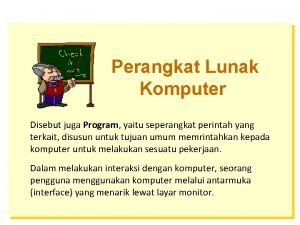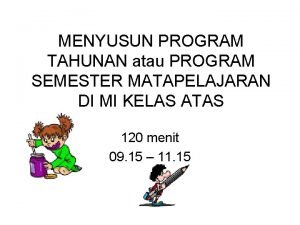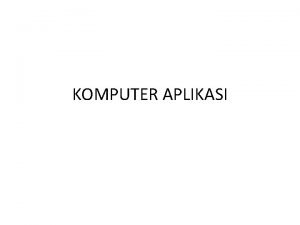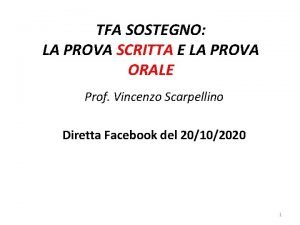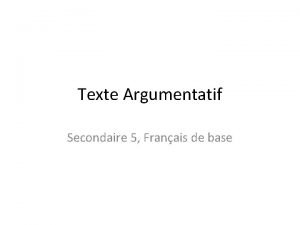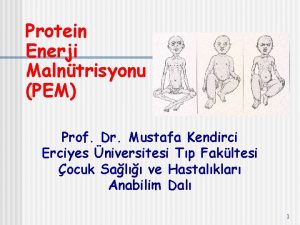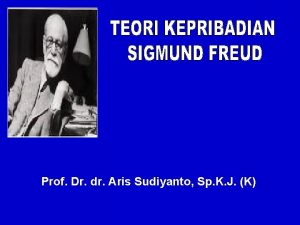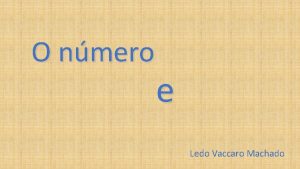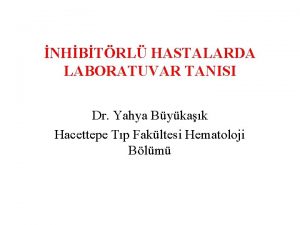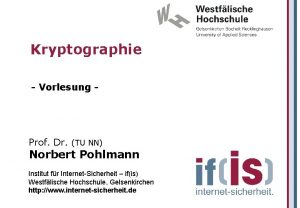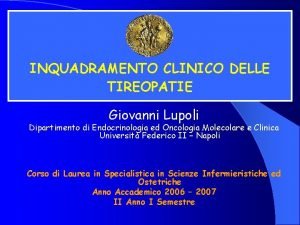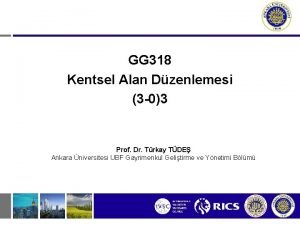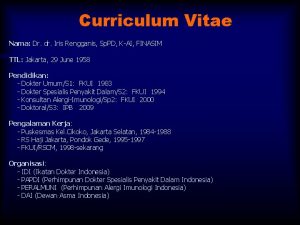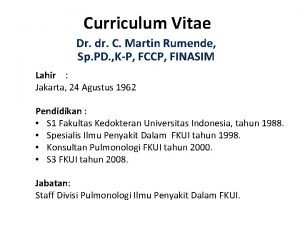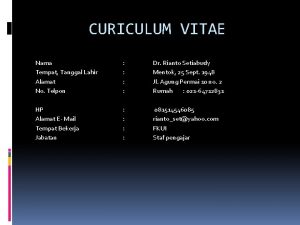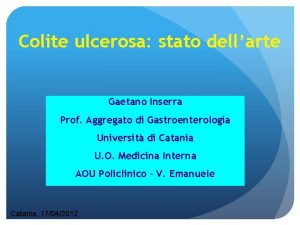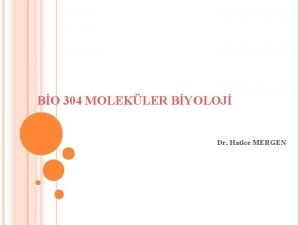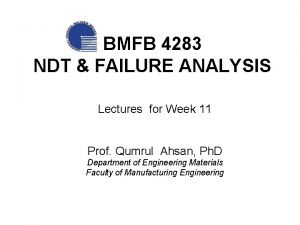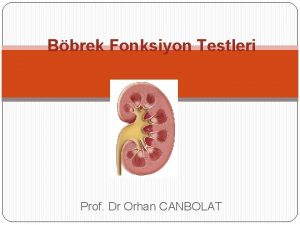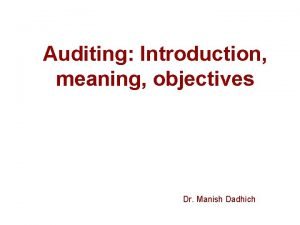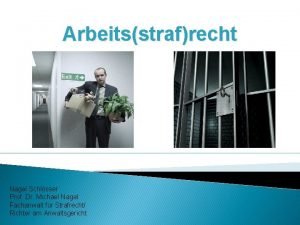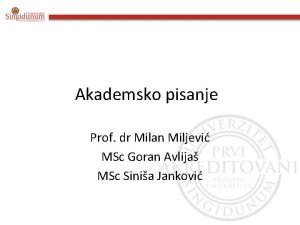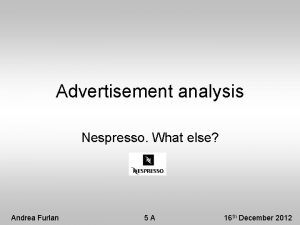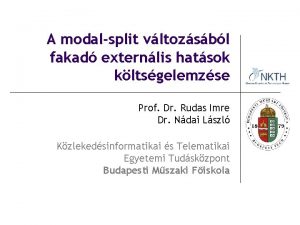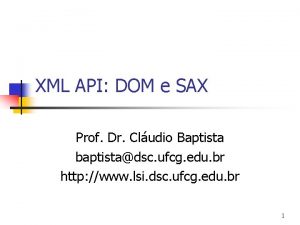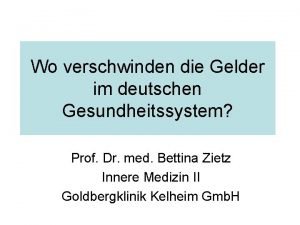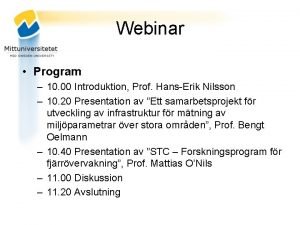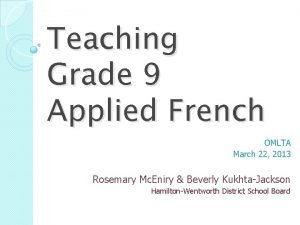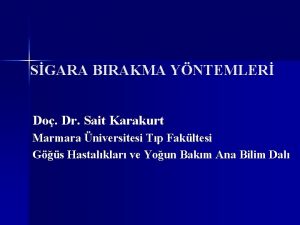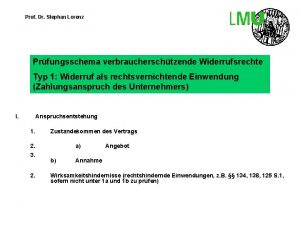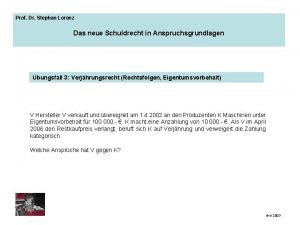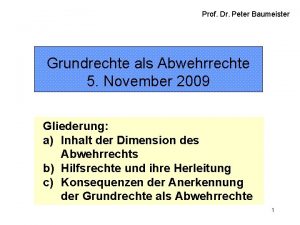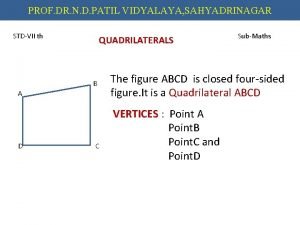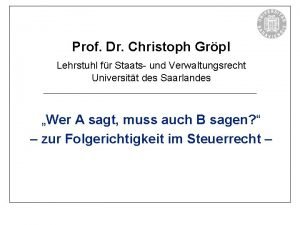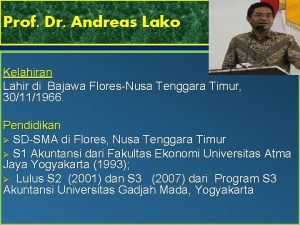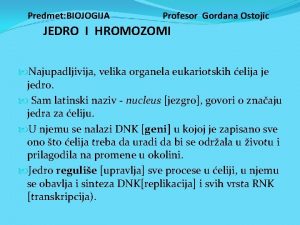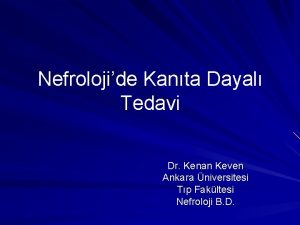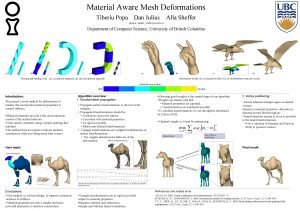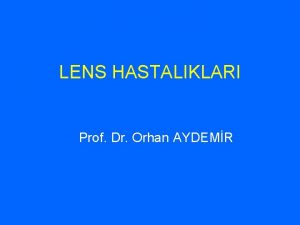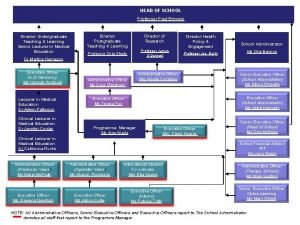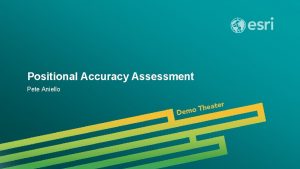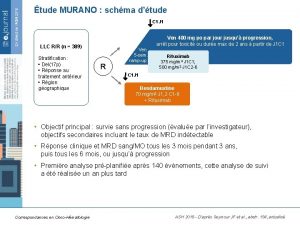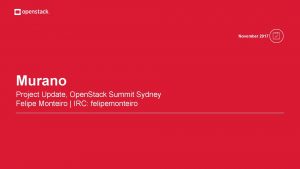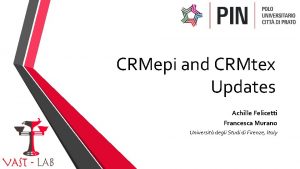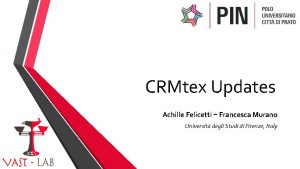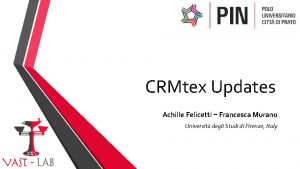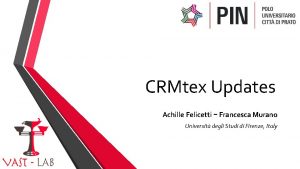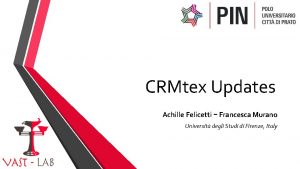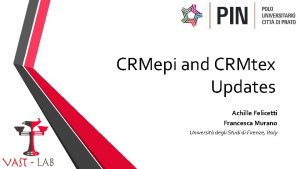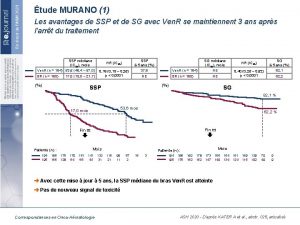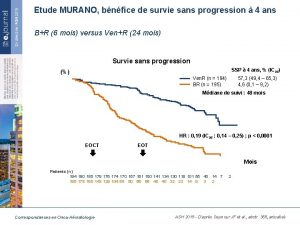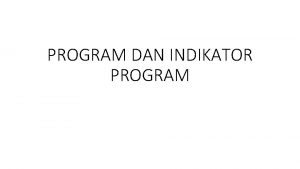C How to Program 7e Prof Aniello Murano



































































































































- Slides: 131

C How to Program, 7/e Prof. Aniello Murano Dott. ssa Loredana Sorrentino © 1992 -2013 by Pearson Education, Inc. All Rights Reserved.

Obiettivi In questa lezione vedremo: - Come utilizzare le tecniche di base di problem solving; - come utilizzare lo statement if and if… else; - come utilizzare lo statement while per ottenere parti del codice ripetute indefinitamente; - uso di valori sentinella e di operatori di incremento, decremento ed assegnamento

Before writing a program to solve a particular problem, we must have a thorough understanding of the problem and a carefully planned solution approach. ◦ Algorithm ◦ Pseudocode ◦ Control structure © 1992 -2013 by Pearson Education, Inc. All Rights Reserved.

The solution to any computing problem involves executing a series of actions in a specific order. A procedure for solving a problem in terms of ◦ the actions to be executed, and ◦ the order in which these actions are to be executed is called an algorithm. Correctly specifying the order in which the actions are to be executed is important. © 1992 -2013 by Pearson Education, Inc. All Rights Reserved.

Consider the “rise-and-shine algorithm” followed by one junior executive for getting out of bed and going to work: (1) Get out of bed, (2) take off pajamas, (3) take a shower, (4) get dressed, (5) eat breakfast, (6) carpool to work. This routine gets the executive to work well prepared to make critical decisions. © 1992 -2013 by Pearson Education, Inc. All Rights Reserved.

Suppose that the same steps are performed in a slightly different order: (1) Get out of bed, (2) take off pajamas, (3) get dressed, (4) take a shower, (5) eat breakfast, (6) carpool to work. In this case, our junior executive shows up for work soaking wet. Specifying the order in which statements are to be executed in a computer program is called program control. © 1992 -2013 by Pearson Education, Inc. All Rights Reserved.

Pseudocode is an artificial and informal language that helps you develop algorithms. Pseudocode is similar to everyday English/Italian; it’s convenient and user friendly although it’s not an actual computer programming language. Pseudocode programs are not executed on computers. Rather, they help you “think out” a program before attempting to write it in a programming language like C. © 1992 -2013 by Pearson Education, Inc. All Rights Reserved.

A carefully prepared pseudocode program may be converted easily to a corresponding C program. Pseudocode consists only of action statements. Definitions are not executable statements. © 1992 -2013 by Pearson Education, Inc. All Rights Reserved.

Normally, statements in a program are executed one after the other in the order in which they’re written. This is called sequential execution. Various C statements we’ll soon discuss enable you to specify that the next statement to be executed may be other than the next one in sequence. This is called transfer of control. During the 1960 s, it became clear that the indiscriminate use of transfers of control was the root of a great deal of difficulty experienced by software development groups. (go to example!!!!!) © 1992 -2013 by Pearson Education, Inc. All Rights Reserved.

Research had demonstrated that all programs could be written in terms of only three control structures, namely the sequence structure, the selection structure and the repetition structure. © 1992 -2013 by Pearson Education, Inc. All Rights Reserved.

The sequence structure is simple—unless directed otherwise, the computer executes C statements one after the other in the order in which they’re written. The flowchart segment of Fig. 3. 1 illustrates C’s sequence structure. Flowcharts A flowchart is a graphical representation of an algorithm or of a portion of an algorithm. Flowcharts are drawn using certain special-purpose symbols such as rectangles, diamonds, rounded rectangles, and small circles; these symbols are connected by arrows called flowlines. © 1992 -2013 by Pearson Education, Inc. All Rights Reserved.

Like pseudocode, flowcharts are useful for developing and representing algorithms, although pseudocode is preferred by most programmers. Consider the flowchart for the sequence structure in Fig. 3. 1. We use the rectangle symbol, also called the action symbol, to indicate any type of action including a calculation or an input/output operation. The flowlines in the figure indicate the order in which the actions are performed—first, grade is added to total, then 1 is added to counter. C allows us to have as many actions as we want in a sequence structure. © 1992 -2013 by Pearson Education, Inc. All Rights Reserved.

© 1992 -2013 by Pearson Education, Inc. All Rights Reserved.

Selection Statements in C C provides three types of selection structures in the form of statements. The if selection statement (Section 3. 5) either selects (performs) an action if a condition is true or skips the action if the condition is false. The if…else selection statement (Section 3. 6) performs an action if a condition is true and performs a different action if the condition is false. The switch selection statement (discussed in Chapter 4) performs one of many different actions depending on the value of an expression. © 1992 -2013 by Pearson Education, Inc. All Rights Reserved.

The if statement is called a single-selection statement because it selects or ignores a single action. The if…else statement is called a double-selection statement because it selects between two different actions. The switch statement is called a multiple-selection statement because it selects among many different actions. Repetition Statements in C C provides three types of repetition structures in the form of statements, namely while (Section 3. 7), do…while, and for (both discussed in Chapter 4). That’s all there is. © 1992 -2013 by Pearson Education, Inc. All Rights Reserved.

C has only seven control statements: sequence, three types of selection and three types of repetition. Each C program is formed by combining as many of each type of control statement as is appropriate for the algorithm the program implements. As with the sequence structure of Fig. 3. 1, we’ll see that the flowchart representation of each control statement has two small circle symbols, one at the entry point to the control statement and one at the exit point. These single-entry/single-exit control statements make it easy to build clear programs. © 1992 -2013 by Pearson Education, Inc. All Rights Reserved.

Selection statements are used to choose among alternative courses of action. For example, suppose the passing grade on an exam is 60. The pseudocode statement ◦ If student’s grade is greater than or equal to 60 Print “Passed” determines whether the condition “student’s grade is greater than or equal to 60” is true or false. If the condition is true, then “Passed” is printed, and the next pseudocode statement in order is “performed” (remember that pseudocode isn’t a real programming language). © 1992 -2013 by Pearson Education, Inc. All Rights Reserved.

If the condition is false, the printing is ignored, and the next pseudocode statement in order is performed. The second line of this selection structure is indented. Such indentation is optional, but it’s highly recommended as it helps emphasize the inherent structure of structured programs. The C compiler ignores white-space characters such as blanks, tabs and newlines used for indentation and vertical spacing. © 1992 -2013 by Pearson Education, Inc. All Rights Reserved.

The preceding pseudocode If statement may be written in C as if ( grade >= 60 ) { printf( "Passedn" ); } /* end if */ Notice that the C code corresponds closely to the pseudocode (of course you’ll also need to declare the int variable grade). © 1992 -2013 by Pearson Education, Inc. All Rights Reserved.

The flowchart of Fig. 3. 2 illustrates the single-selection if statement. This flowchart contains what is perhaps the most important flowcharting symbol—the diamond symbol, also called the decision symbol, which indicates that a decision is to be made. The decision symbol contains an expression, such as a condition, that can be either true or false. © 1992 -2013 by Pearson Education, Inc. All Rights Reserved.

The decision symbol has two flowlines emerging from it. One indicates the direction to take when the expression in the symbol is true and the other the direction to take when the expression is false. Decisions can be based on conditions containing relational or equality operators. In fact, a decision can be based on any expression—if the expression evaluates to zero, it’s treated as false, and if it evaluates to nonzero, it’s treated as true. © 1992 -2013 by Pearson Education, Inc. All Rights Reserved.

© 1992 -2013 by Pearson Education, Inc. All Rights Reserved.

The if…else selection statement allows you to specify that different actions are to be performed when the condition is true and when it’s false. For example, the pseudocode statement ◦ If student’s grade is greater than or equal to 60 Print “Passed” else Print “Failed” prints Passed if the student’s grade is greater than or equal to 60 and Failed if the student’s grade is less than 60. In either case, after printing occurs, the next pseudocode statement in sequence is “performed. ” The body of the else is also indented. © 1992 -2013 by Pearson Education, Inc. All Rights Reserved.

© 1992 -2013 by Pearson Education, Inc. All Rights Reserved.

© 1992 -2013 by Pearson Education, Inc. All Rights Reserved.

The preceding pseudocode If…else statement may be written in C as if ( grade >= 60 ) { printf( "Passedn" ); } /* end if */ else { printf( "Failedn" ); } /* end else */ The flowchart of Fig. 3. 3 illustrates the flow of control in the if…else statement. Once again, besides small circles and arrows, the only symbols in the flowchart are rectangles for actions and a diamond for a decision. © 1992 -2013 by Pearson Education, Inc. All Rights Reserved.

© 1992 -2013 by Pearson Education, Inc. All Rights Reserved.

C provides the conditional operator (? : ) which is closely related to the if…else statement. The conditional operator is C’s only ternary operator— it takes three operands. These together with the conditional operator form a conditional expression. The first operand is a condition. The second operand is the value for the entire conditional expression if the condition is true and the operand is the value for the entire conditional expression if the condition is false. © 1992 -2013 by Pearson Education, Inc. All Rights Reserved.

For example, the puts statement puts( grade >= 60 ? "Passed" : "Failed" ); contains as its second argument a conditional expression that evaluates to the string "Passed" if the condition grade >= 60 is true and to the string "Failed" if the condition is false. The puts statement performs in essentially the same way as the preceding if…else statement. © 1992 -2013 by Pearson Education, Inc. All Rights Reserved.

The second and third operands in a conditional expression can also be actions to be executed. For example, the conditional expression grade >= 60 ? puts( "Passed" ) : puts( "Failed" ); is read, “If grade is greater than or equal to 60 then puts("Passed"), otherwise puts( "Failed" ). ” This, too, is comparable to the preceding if…else statement. We’ll see that conditional operators can be used in some places where if…else statements cannot. © 1992 -2013 by Pearson Education, Inc. All Rights Reserved.

Nested if. . . else Statements Nested if…else statements test for multiple cases by placing if…else statements inside if…else statements. For example, the following pseudocode statement will print A for exam grades greater than or equal to 90, B for grades greater than or equal to 80 (but less than 90), C for grades greater than or equal to 70 (but less than 80), D for grades greater than or equal to 60 (but less than 70) and F for all other grades. © 1992 -2013 by Pearson Education, Inc. All Rights Reserved.

If student’s grade is greater than or equal to 90 Print “A” else If student’s grade is greater than or equal to 80 Print “B” else If student’s grade is greater than or equal to 70 Print “C” else If student’s grade is greater than or equal to 60 Print “D” else Print “F” © 1992 -2013 by Pearson Education, Inc. All Rights Reserved.

This pseudocode may be written in C as if ( grade >= 90 ) puts( "A" ); else if ( grade >= 80 ) puts("B"); else if ( grade >= 70 ) puts("C"); else if ( grade >= 60 ) puts( "D" ); else puts( "F" ); © 1992 -2013 by Pearson Education, Inc. All Rights Reserved.

If the variable grade is greater than or equal to 90, all four conditions will be true, but only the puts statement after the first test will be executed. After that puts is executed, the else part of the “outer” if…else statement is skipped. © 1992 -2013 by Pearson Education, Inc. All Rights Reserved.

You may prefer to write the preceding if statement as if ( grade >= 90 ) puts( "A" ); else if ( grade >= 80 ) puts( "B" ); else if ( grade >= 70 ) puts( "C" ); else if ( grade >= 60 ) puts( "D" ); else puts( "F" ); © 1992 -2013 by Pearson Education, Inc. All Rights Reserved.

The following example includes a compound statement in the else part of an if…else statement. if ( grade >= 60 ) { puts( "Passed. " ); } /* end if */ else { puts( "Failed. " ); puts( "You must take this course again. " ); } /* end else */ © 1992 -2013 by Pearson Education, Inc. All Rights Reserved.

In this case, if grade is less than 60, the program executes both puts statements in the body of the else and prints Failed. You must take this course again. The braces surrounding the two statements in the else are important. Without them, the statement puts( "You must take this course again. " ); would be outside the body of the else part of the if and would execute regardless of whether the grade was less than 60. © 1992 -2013 by Pearson Education, Inc. All Rights Reserved.

A repetition statement (also called an iteration statement) allows you to specify that an action is to be repeated while some condition remains true. The pseudocode statement ◦ While there are more items on my shopping list Purchase next item and cross it off my list describes the repetition that occurs during a shopping trip. The condition, “there are more items on my shopping list” may be true or false. If it’s true, then the action, “Purchase next item and cross it off my list” is performed. This action will be performed repeatedly while the condition remains true. © 1992 -2013 by Pearson Education, Inc. All Rights Reserved.

The statement(s) contained in the while repetition statement constitute the body of the while. The while statement body may be a single statement or a compound statement. Eventually, the condition will become false (when the last item on the shopping list has been purchased and crossed off the list). At this point, the repetition terminates, and the first pseudocode statement after the repetition structure is executed. © 1992 -2013 by Pearson Education, Inc. All Rights Reserved.

As an example of a while statement, consider a program segment designed to find the first power of 3 larger than 100. Suppose the integer variable product has been initialized to 3. When the following while repetition statement finishes executing, product will contain the desired answer: product = 3; while ( product <= 100 ) { product = 3 * product; } /* end while */ The flowchart of Fig. 3. 4 illustrates the flow of control in the while repetition statement. © 1992 -2013 by Pearson Education, Inc. All Rights Reserved.

Once again, note that (besides small circles and arrows) the flowchart contains only a rectangle symbol and a diamond symbol. The flowchart clearly shows the repetition. The flowline emerging from the rectangle wraps back to the decision, which is tested each time through the loop until the decision eventually becomes false. At this point, the while statement is exited and control passes to the next statement in the program. © 1992 -2013 by Pearson Education, Inc. All Rights Reserved.

© 1992 -2013 by Pearson Education, Inc. All Rights Reserved.

When the while statement is entered, the value of product is 3. The variable product is repeatedly multiplied by 3, taking on the values 9, 27 and 81 successively. When product becomes 243, the condition in the while statement, product <= 100, becomes false. This terminates the repetition, and the final value of product is 243. Program execution continues with the next statement after the while. © 1992 -2013 by Pearson Education, Inc. All Rights Reserved.

To illustrate how algorithms are developed, we solve several variations of a class-averaging problem. Consider the following problem statement: ◦ A class of ten students took a quiz. The grades (integers in the range 0 to 100) for this quiz are available to you. Determine the class average on the quiz. The class average is equal to the sum of the grades divided by the number of students. The algorithm for solving this problem on a computer must input each of the grades, perform the averaging calculation, and print the result. © 1992 -2013 by Pearson Education, Inc. All Rights Reserved.

Let’s use pseudocode to list the actions to execute and specify the order in which these actions should execute. We use counter-controlled repetition to input the grades one at a time. This technique uses a variable called a counter to specify the number of times a set of statements should execute. In this example, repetition terminates when the counter exceeds 10. © 1992 -2013 by Pearson Education, Inc. All Rights Reserved.

In this section we simply present the pseudocode algorithm (Fig. 3. 5) and the corresponding C program (Fig. 3. 6). In the next section we show pseudocode algorithms are developed. Counter-controlled repetition is often called definite repetition because the number of repetitions is known before the loop begins executing. © 1992 -2013 by Pearson Education, Inc. All Rights Reserved.

© 1992 -2013 by Pearson Education, Inc. All Rights Reserved.

© 1992 -2013 by Pearson Education, Inc. All Rights Reserved.

© 1992 -2013 by Pearson Education, Inc. All Rights Reserved.

The algorithm mentions a total and a counter. A total is a variable used to accumulate the sum of a series of values. A counter is a variable (line 8) used to count—in this case, to count the number of grades entered. Because the counter variable is used to count from 1 to 10 in this program (all positive values), we declared the variable as an unsigned int, which can store only non-negative values (that is, 0 and higher). © 1992 -2013 by Pearson Education, Inc. All Rights Reserved.

Variables used to store totals should normally be initialized to zero before being used in a program; otherwise the sum would include the previous value stored in the total’s memory location. Counter variables are normally initialized to zero or one, depending on their use (we’ll present examples of each). An uninitialized variable contains a “garbage” value— the value last stored in the memory location reserved for that variable. © 1992 -2013 by Pearson Education, Inc. All Rights Reserved.

The averaging calculation in the program produced an integer result of 81. Actually, the sum of the grades in this example is 817, which when divided by 10 should yield 81. 7, i. e. , a number with a decimal point. We’ll see how to deal with such numbers (called floating-point numbers) in the next section. © 1992 -2013 by Pearson Education, Inc. All Rights Reserved.

Let’s generalize the class-average problem. Consider the following problem: ◦ Develop a class-averaging program that will process an arbitrary number of grades each time the program is run. In the first class-average example, the number of grades (10) was known in advance. In this example, the program must process an arbitrary number of grades. How can the program determine when to stop the input of grades? How will it know when to calculate and print the class average? © 1992 -2013 by Pearson Education, Inc. All Rights Reserved.

One way to solve this problem is to use a special value called a sentinel value (also called a signal value, a dummy value, or a flag value) to indicate “end of data entry. ” The user types in grades until all legitimate grades have been entered. The user then types the sentinel value to indicate “the last grade has been entered. ” Sentinel-controlled repetition is often called indefinite repetition because the number of repetitions isn’t known before the loop begins executing. © 1992 -2013 by Pearson Education, Inc. All Rights Reserved.

Clearly, the sentinel value must be chosen so that it cannot be confused with an acceptable input value. Because grades on a quiz are normally nonnegative integers, – 1 is an acceptable sentinel value for this problem. Thus, a run of the class-average program might process a stream of inputs such as 95, 96, 75, 74, 89 and – 1. The program would then compute and print the class average for the grades 95, 96, 75, 74, and 89 (– 1 is the sentinel value, so it should not enter into the averaging calculation). © 1992 -2013 by Pearson Education, Inc. All Rights Reserved.

Top-Down, Stepwise Refinement We approach the class-average program with a technique called top-down, stepwise refinement, a technique that is essential to the development of well-structured programs. We begin with a pseudocode representation of the top: ◦ Determine the class average for the quiz The top is a single statement that conveys the program’s overall function. As such, the top is, in effect, a complete representation of a program. © 1992 -2013 by Pearson Education, Inc. All Rights Reserved.

Unfortunately, the top rarely conveys a sufficient amount of detail for writing the C program. So we now begin the refinement process. We divide the top into a series of smaller tasks and list these in the order in which they need to be performed. This results in the following first refinement. ◦ Initialize variables Input, sum, and count the quiz grades Calculate and print the class average Here, only the sequence structure has been used—the steps listed are to be executed in order, one after the other. © 1992 -2013 by Pearson Education, Inc. All Rights Reserved.

© 1992 -2013 by Pearson Education, Inc. All Rights Reserved.

Second Refinement To proceed to the next level of refinement, i. e. , the second refinement, we commit to specific variables. We need a running total of the numbers, a count of how many numbers have been processed, a variable to receive the value of each grade as it’s input and a variable to hold the calculated average. The pseudocode statement ◦ Initialize variables may be refined as follows: ◦ Initialize total to zero Initialize counter to zero © 1992 -2013 by Pearson Education, Inc. All Rights Reserved.

Only the total and counter need to be initialized; the variables average and grade (for the calculated average and the user input, respectively) need not be initialized because their values will be written over by the process of destructive read-in discussed in Chapter 2. The pseudocode statement ◦ Input, sum, and count the quiz grades requires a repetition structure that successively inputs each grade. Because we do not know in advance how many grades are to be processed, we’ll use sentinel-controlled repetition. © 1992 -2013 by Pearson Education, Inc. All Rights Reserved.

The user will enter legitimate grades in one at a time. After the last legitimate grade is typed, the user will type the sentinel value. The program will test for this value after each grade is input and will terminate the loop when the sentinel is entered. The refinement of the preceding pseudocode statement is then ◦ Input the first grade While the user has not as yet entered the sentinel Add this grade into the running total Add one to the grade counter Input the next grade (possibly the sentinel) © 1992 -2013 by Pearson Education, Inc. All Rights Reserved.

Notice that in pseudocode, we do not use braces around the set of statements that form the body of the while statement. We simply indent all these statements under the while to show that they all belong to the while. Again, pseudocode is an informal program development aid. © 1992 -2013 by Pearson Education, Inc. All Rights Reserved.

The pseudocode statement ◦ Calculate and print the class average may be refined as follows: ◦ If the counter is not equal to zero Set the average to the total divided by the counter Print the average else Print “No grades were entered” Notice that we’re being careful here to test for the possibility of division by zero—a fatal error that if undetected would cause the program to fail (often called “crashing”). The complete second refinement is shown in Fig. 3. 7. © 1992 -2013 by Pearson Education, Inc. All Rights Reserved.

© 1992 -2013 by Pearson Education, Inc. All Rights Reserved.

© 1992 -2013 by Pearson Education, Inc. All Rights Reserved.

In Fig. 3. 5 and Fig. 3. 7, we include some completely blank lines in the pseudocode for readability. Actually, the blank lines separate these programs into their various phases. © 1992 -2013 by Pearson Education, Inc. All Rights Reserved.

© 1992 -2013 by Pearson Education, Inc. All Rights Reserved.

© 1992 -2013 by Pearson Education, Inc. All Rights Reserved.

The pseudocode algorithm in Fig. 3. 7 solves the more general class-averaging problem. This algorithm was developed after only two levels of refinement. Sometimes more levels are necessary. © 1992 -2013 by Pearson Education, Inc. All Rights Reserved.

© 1992 -2013 by Pearson Education, Inc. All Rights Reserved.

The C program and a sample execution are shown in Fig. 3. 8. Although only integer grades are entered, the averaging calculation is likely to produce a number with a decimal point. The type int cannot represent such a number. The program introduces the data type float to handle numbers with decimal points (called floating-point numbers) and introduces a special operator called a cast operator to handle the averaging calculation. These features are explained after the program is presented. © 1992 -2013 by Pearson Education, Inc. All Rights Reserved.

© 1992 -2013 by Pearson Education, Inc. All Rights Reserved.

© 1992 -2013 by Pearson Education, Inc. All Rights Reserved.

© 1992 -2013 by Pearson Education, Inc. All Rights Reserved.

Notice the compound statement in the while loop (line 24) in Fig. 3. 8 Once again, the braces are necessary to ensure that all four statements are executed within the loop. Without the braces, the last three statements in the body of the loop would fall outside the loop, causing the computer to interpret this code incorrectly as follows. while ( grade != -1 ) total = total + grade; /* add grade to total */ counter = counter + 1; /* increment counter */ printf( "Enter grade, -1 to end: " ); /* prompt for input */ scanf( "%d", &grade ); /* read next grade */ This would cause an infinite loop if the user did not input 1 for the first grade. © 1992 -2013 by Pearson Education, Inc. All Rights Reserved.

© 1992 -2013 by Pearson Education, Inc. All Rights Reserved.

Converting Between Types Explicitly and Implicitly Averages do not always evaluate to integer values. Often, an average is a value such as 7. 2 or – 93. 5 that contains a fractional part. These values are referred to as floating-point numbers and can be represented by the data type float. The variable average is defined to be of type float (line 12) to capture the fractional result of our calculation. However, the result of the calculation total / counter is an integer because total and counter are both integer variables. © 1992 -2013 by Pearson Education, Inc. All Rights Reserved.

Dividing two integers results in integer division in which any fractional part of the calculation is truncated (i. e. , lost). Because the calculation is performed first, the fractional part is lost before the result is assigned to average. To produce a floating-point calculation with integer values, we must create temporary values that are floating-point numbers. C provides the unary cast operator to accomplish this task. © 1992 -2013 by Pearson Education, Inc. All Rights Reserved.

Line 38 average = ( float ) total / counter; includes the cast operator (float), which creates a temporary floating-point copy of its operand, total. The value stored in total is still an integer. Using a cast operator in this manner is called explicit conversion. The calculation now consists of a floating-point value (the temporary float version of total) divided by the unsigned int value stored in counter. © 1992 -2013 by Pearson Education, Inc. All Rights Reserved.

C evaluates arithmetic expressions only in which the data types of the operands are identical. To ensure that the operands are of the same type, the compiler performs an operation called implicit conversion on selected operands. For example, in an expression containing the data types unsigned int and float, copies of unsigned int operands are made and converted to float. In our example, after a copy of counter is made and converted to float, the calculation is performed and the result of the floating-point division is assigned to average. © 1992 -2013 by Pearson Education, Inc. All Rights Reserved.

C provides a set of rules for convertion of operands of different types. We discuss this further in Chapter 5. Cast operators are available for most data types—they’re formed by placing parentheses around a type name. Each cast operator is a unary operator, i. e. , an operator that takes only one operand. C also supports unary versions of the plus (+) and minus (-) operators, so you can write expressions such as -7 or +5. © 1992 -2013 by Pearson Education, Inc. All Rights Reserved.

Cast operators associate from right to left and have the same precedence as other unary operators such as unary + and unary -. This precedence is one level higher than that of the multiplicative operators *, / and %. Formatting Floating-Point Numbers Figure 3. 8 uses the printf conversion specifier %. 2 f (line 41) to print the value of average. The f specifies that a floating-point value will be printed. The. 2 is the precision with which the value will be displayed—with 2 digits to the right of the decimal point. © 1992 -2013 by Pearson Education, Inc. All Rights Reserved.

If the %f conversion specifier is used (without specifying the precision), the default precision of 6 is used—exactly as if the conversion specifier %. 6 f had been used. When floating-point values are printed with precision, the printed value is rounded to the indicated number of decimal positions. The value in memory is unaltered. When the following statements are executed, the values 3. 45 and 3. 4 are printed. printf( "%. 2 fn", 3. 446 ); /* prints 3. 45 */ printf( "%. 1 fn", 3. 446 ); /* prints 3. 4 */ © 1992 -2013 by Pearson Education, Inc. All Rights Reserved.

© 1992 -2013 by Pearson Education, Inc. All Rights Reserved.

Notes on Floating-Point Numbers Although floating-point numbers are not always “ 100% precise, ” they have numerous applications. For example, when we speak of a “normal” body temperature of 98. 6, we do not need to be precise to a large number of digits. When we view the temperature on a thermometer and read it as 98. 6, it may actually be 98. 5999473210643. The point here is that calling this number simply 98. 6 is fine for most applications. © 1992 -2013 by Pearson Education, Inc. All Rights Reserved.

Another way floating-point numbers develop is through division. When we divide 10 by 3, the result is 3. 3333333… with the sequence of 3 s repeating infinitely. The computer allocates only a fixed amount of space to hold such a value, so the stored floating-point value can be only an approximation. © 1992 -2013 by Pearson Education, Inc. All Rights Reserved.

© 1992 -2013 by Pearson Education, Inc. All Rights Reserved.

© 1992 -2013 by Pearson Education, Inc. All Rights Reserved.

Let’s work another complete problem. We’ll once again formulate the algorithm using pseudocode and top-down, stepwise refinement, and write a corresponding C program. We’ve seen that control statements may be stacked on top of one another (in sequence) just as a child stacks building blocks. In this case study we’ll see the only other structured way control statements may be connected in C, namely through nesting of one control statement within another. © 1992 -2013 by Pearson Education, Inc. All Rights Reserved.

Consider the following problem statement: ◦ A college offers a course that prepares students for the state licensing exam for real estate brokers. Last year, 10 of the students who completed this course took the licensing examination. Naturally, the college wants to know how well its students did on the exam. You’ve been asked to write a program to summarize the results. You’ve been given a list of these 10 students. Next to each name a 1 is written if the student passed the exam and a 2 if the student failed. © 1992 -2013 by Pearson Education, Inc. All Rights Reserved.

Your program should analyze the results of the exam as follows: ◦ Input each test result (i. e. , a 1 or a 2). Display the prompting message “Enter result” each time the program requests another test result. ◦ Count the number of test results of each type. ◦ Display a summary of the test results indicating the number of students who passed and the number who failed. ◦ If more than eight students passed the exam, print the message “Bonus to instructor!” © 1992 -2013 by Pearson Education, Inc. All Rights Reserved.

After reading the problem statement carefully, we make the following observations: ◦ The program must process 10 test results. A counter-controlled loop will be used. ◦ Each test result is a number—either a 1 or a 2. Each time the program reads a test result, the program must determine whether the number is a 1 or a 2. We test for a 1 in our algorithm. If the number is not a 1, we assume that it’s a 2. (An exercise at the end of the chapter considers the consequences of this assumption. ) ◦ Two counters are used—one to count the number of students who passed the exam and one to count the number of students who failed the exam. ◦ After the program has processed all the results, it must decide whether more than 8 students passed the exam. © 1992 -2013 by Pearson Education, Inc. All Rights Reserved.

Let’s proceed with top-down, stepwise refinement. We begin with a pseudocode representation of the top: ◦ Analyze exam results and decide if instructor should receive a bonus Once again, it’s important to emphasize that the top is a complete representation of the program, but several refinements are likely to be needed before the pseudocode can be naturally evolved into a C program. © 1992 -2013 by Pearson Education, Inc. All Rights Reserved.

Our first refinement is ◦ Initialize variables Input the ten quiz grades and count passes and failures Print a summary of the exam results and decide if instructor should receive a bonus Here, too, even though we have a complete representation of the entire program, further refinement is necessary. We now commit to specific variables. Counters are needed to record the passes and failures, a counter will be used to control the looping process, and a variable is needed to store the user input. © 1992 -2013 by Pearson Education, Inc. All Rights Reserved.

The pseudocode statement ◦ Initialize variables may be refined as follows: ◦ Initialize passes to zero Initialize failures to zero Initialize student to one Notice that only the counters and totals are initialized. The pseudocode statement ◦ Input the ten quiz grades and count passes and failures requires a loop that successively inputs the result of each exam. © 1992 -2013 by Pearson Education, Inc. All Rights Reserved.

Here it’s known in advance that there are precisely ten exam results, so counter-controlled looping is appropriate. Inside the loop (i. e. , nested within the loop) a doubleselection statement will determine whether each exam result is a pass or a failure and will increment the appropriate counters accordingly. © 1992 -2013 by Pearson Education, Inc. All Rights Reserved.

The refinement of the preceding pseudocode statement is then ◦ While student counter is less than or equal to ten Input the next exam result If the student passed Add one to passes else Add one to failures Add one to student counter Notice the use blank lines to set off the If…else to improve program readability. © 1992 -2013 by Pearson Education, Inc. All Rights Reserved.

The pseudocode statement ◦ Print a summary of the exam results and decide if instructor should receive a bonus may be refined as follows: ◦ Print the number of passes Print the number of failures If more than eight students passed Print “Bonus to instructor!” The complete second refinement appears in Fig. 3. 9. We use blank lines to set off the while statement for program readability. © 1992 -2013 by Pearson Education, Inc. All Rights Reserved.

This pseudocode is now sufficiently refined for conversion to C. The C program and two sample executions are shown in Fig. 3. 10. We’ve taken advantage of a feature of C that allows initialization to be incorporated into definitions. Such initialization occurs at compile time. Also, notice that when you output an unsigned int you use the %u conversion specifier. © 1992 -2013 by Pearson Education, Inc. All Rights Reserved.

© 1992 -2013 by Pearson Education, Inc. All Rights Reserved.

© 1992 -2013 by Pearson Education, Inc. All Rights Reserved.

© 1992 -2013 by Pearson Education, Inc. All Rights Reserved.

© 1992 -2013 by Pearson Education, Inc. All Rights Reserved.

© 1992 -2013 by Pearson Education, Inc. All Rights Reserved.

© 1992 -2013 by Pearson Education, Inc. All Rights Reserved.

© 1992 -2013 by Pearson Education, Inc. All Rights Reserved.

C provides several assignment operators for abbreviating assignment expressions. For example, the statement c = c + 3; can be abbreviated with the addition assignment operator += as c += 3; The += operator adds the value of the expression on the right of the operator to the value of the variable on the left of the operator and stores the result in the variable on the left of the operator. © 1992 -2013 by Pearson Education, Inc. All Rights Reserved.

Any statement of the form variable = variable operator expression; where operator is one of the binary operators +, -, *, / or % (or others we’ll discuss in Chapter 10), can be written in the form variable operator= expression; Thus the assignment c += 3 adds 3 to c. Figure 3. 11 shows the arithmetic assignment operators, sample expressions using these operators and explanations. © 1992 -2013 by Pearson Education, Inc. All Rights Reserved.

© 1992 -2013 by Pearson Education, Inc. All Rights Reserved.

C also provides the unary increment operator, ++, and the unary decrement operator, --, which are summarized in Fig. 3. 12. If a variable c is to be incremented by 1, the increment operator ++ can be used rather than the expressions c = c + 1 or c += 1. If increment or decrement operators are placed before a variable (i. e. , prefixed), they’re referred to as the preincrement or predecrement operators, respectively. If increment or decrement operators are placed after a variable (i. e. , postfixed), they’re referred to as the postincrement or postdecrement operators, respectively. © 1992 -2013 by Pearson Education, Inc. All Rights Reserved.

Preincrementing (predecrementing) a variable causes the variable to be incremented (decremented) by 1, then the new value of the variable is used in the expression in which it appears. Postincrementing (postdecrementing) the variable causes the current value of the variable to be used in the expression in which it appears, then the variable value is incremented (decremented) by 1. © 1992 -2013 by Pearson Education, Inc. All Rights Reserved.

© 1992 -2013 by Pearson Education, Inc. All Rights Reserved.

Figure 3. 13 demonstrates the difference between the preincrementing and the postincrementing versions of the ++ operator. Postincrementing the variable c causes it to be incremented after it’s used in the printf statement. Preincrementing the variable c causes it to be incremented before it’s used in the printf statement. © 1992 -2013 by Pearson Education, Inc. All Rights Reserved.

© 1992 -2013 by Pearson Education, Inc. All Rights Reserved.

© 1992 -2013 by Pearson Education, Inc. All Rights Reserved.

The program displays the value of c before and after the ++ operator is used. The decrement operator (--) works similarly. © 1992 -2013 by Pearson Education, Inc. All Rights Reserved.

© 1992 -2013 by Pearson Education, Inc. All Rights Reserved.

The three assignment statements in Fig. 3. 10 passes = passes + 1; failures = failures + 1; student = student + 1; can be written more concisely with assignment operators as passes += 1; failures += 1; student += 1; with preincrement operators as ++passes; ++failures; ++student; or with postincrement operators as passes++; failures++; student++; © 1992 -2013 by Pearson Education, Inc. All Rights Reserved.

It’s important to note here that when incrementing or decrementing a variable in a statement by itself, the preincrement and postincrement forms have the same effect. © 1992 -2013 by Pearson Education, Inc. All Rights Reserved.

It’s only when a variable appears in the context of a larger expression that preincrementing and postincrementing have different effects (and similarly for predecrementing and postdecrementing). Of the expressions we’ve studied thus far, only a simple variable name may be used as the operand of an increment or decrement operator. © 1992 -2013 by Pearson Education, Inc. All Rights Reserved.

© 1992 -2013 by Pearson Education, Inc. All Rights Reserved.

© 1992 -2013 by Pearson Education, Inc. All Rights Reserved.

Figure 3. 14 lists the precedence and associativity of the operators introduced to this point. The operators are shown top to bottom in decreasing order of precedence. The second column indicates the associativity of the operators at each level of precedence. Notice that the conditional operator (? : ), the unary operators increment (++), decrement (--), plus (+), minus ( -) and casts, and the assignment operators =, +=, -=, *=, /= and %= associate from right to left. The third column names the various groups of operators. All other operators in Fig. 3. 14 associate from left to right. © 1992 -2013 by Pearson Education, Inc. All Rights Reserved.

© 1992 -2013 by Pearson Education, Inc. All Rights Reserved.

Arithmetic Overflow Figure 2. 5 presented an addition program which calculated the sum of two int values (line 18) with the statement sum = integer 1 + integer 2; // assign total to sum Even this simple statement has a potential problem—adding the integers could result in a value that’s too large to store in an int variable. This is known as arithmetic overflow and can cause undefined behavior, possibly leaving a system open to attack. © 1992 -2013 by Pearson Education, Inc. All Rights Reserved.

The maximum and minimum values that can be stored in an int variable are represented by the constants INT_MAX and INT_MIN, respectively, which are defined in the header <limits. h>. You can see your platform’s values for these constants by opening the header <limits. h> in a text editor. It’s considered a good practice to ensure that before you perform arithmetic calculations like the one in line 18 of Fig. 2. 5, they will not overflow. The code for doing this is shown on the CERT website www. securecoding. cert. org—just search for guideline “INT 32 -C. ” The code uses the && (logical AND) and || (logical OR) operators, which are introduced in the Chapter 4. © 1992 -2013 by Pearson Education, Inc. All Rights Reserved.

Unsigned Integers In Fig. 3. 6, line 8 declared as an unsigned int the variable counter because it’s used to count only non-negative values. In general, counters that should store only non-negative values should be declared with unsigned before the integer type. Variables of unsigned types can represent values from 0 to approximately twice the positive range of the corresponding signed integer types. You can determine your platform’s maximum unsigned int value with the constant UINT_MAX from <limits. h>. © 1992 -2013 by Pearson Education, Inc. All Rights Reserved.

The class-averaging program in Fig. 3. 6 could have declared as unsigned int the variables grade, total and average. Grades are normally values from 0 to 100, so the total and average should each be greater than or equal to 0. We declared those variables as ints because we can’t control what the user actually enters—the user could enter negative values. Worse yet, the user could enter a value that’s not even a number. (We’ll show to deal with such inputs later in the book. ) © 1992 -2013 by Pearson Education, Inc. All Rights Reserved.

Sometimes sentinel-controlled loops use invalid values to terminate a loop. For example, the class-averaging program of Fig. 3. 8 terminates the loop when the user enters the sentinel -1 (an invalid grade), so it would be improper to declare variable grade as an unsigned int. As you’ll see, the end-of-file (EOF) indicator—which is introduced in the next chapter and is often used to terminate sentinel-controlled loops—is also a negative number. © 1992 -2013 by Pearson Education, Inc. All Rights Reserved.

scanf_s and printf_s The C 11 standard’s Annex K introduces more secure versions of printf and scanf called printf_s and scanf_s. Annex K is designated as optional, so not every C vendor will implement it. Microsoft implemented its own versions of printf_s and scanf_s prior to the publication of the C 11 standard and immediately began issuing warnings for every scanf call. The warnings say that scanf is deprecated—it should no longer be used—and that you should consider using scanf_s instead. © 1992 -2013 by Pearson Education, Inc. All Rights Reserved.

1. 2. 3. There are two ways to eliminate Visual C++’s scanf warnings —you can use scanf_s instead of scanf or you can disable these warnings. For the input statements we’ve used so far, Visual C++ users can simply replace scanf with scanf_s. You can disable the warning messages in Visual C++ as follows: Type Alt F 7 to display the Property Pages dialog for your project. In the left column, expand Configuration Properties > C/C++ and select Preprocessor. In the right column, at the end of the value for Preprocessor Definitions, insert ; _CRT_SECURE_NO_WARNINGS 4. Click OK to save the changes. © 1992 -2013 by Pearson Education, Inc. All Rights Reserved.
 Aniello arena
Aniello arena D aniello unimc
D aniello unimc Linfadeniti
Linfadeniti Aniello di meglio
Aniello di meglio Sage murano erp online acceso
Sage murano erp online acceso Openstack murano
Openstack murano Sequential program and an event-driven program?
Sequential program and an event-driven program? Perangkat lunak komputer disebut .... *
Perangkat lunak komputer disebut .... * Program tahunan adalah
Program tahunan adalah Microsoft excel merupakan program aplikasi...
Microsoft excel merupakan program aplikasi... Perangkat lunak pengolah angka buatan microsoft
Perangkat lunak pengolah angka buatan microsoft Program ms word merupakan program …. *
Program ms word merupakan program …. * Prof. dr. marcus eckert
Prof. dr. marcus eckert Ufpb a massa de três átomos de carbono
Ufpb a massa de três átomos de carbono Prof david toback
Prof david toback What is this in english
What is this in english Prof dr suganda tanuwidjaja
Prof dr suganda tanuwidjaja Prof david kipping
Prof david kipping Tracce svolte prova scritta tfa sostegno secondaria pdf
Tracce svolte prova scritta tfa sostegno secondaria pdf Texte argumentatif alloprof
Texte argumentatif alloprof Narracja w syzyfowych pracach
Narracja w syzyfowych pracach Prof. grace schneider
Prof. grace schneider Sonnet by edna analysis
Sonnet by edna analysis Akuisita
Akuisita Radkal
Radkal Prof obsatar sinaga
Prof obsatar sinaga Pem dereceleri
Pem dereceleri Professor mark ferguson
Professor mark ferguson Prof paolo bellioni
Prof paolo bellioni Ramlimusa
Ramlimusa Prof aris
Prof aris Prof agamenon roberto
Prof agamenon roberto Prof dr bilgin arda
Prof dr bilgin arda Epinoryum
Epinoryum Prof jusak nugraha
Prof jusak nugraha Prof umi narimawati
Prof umi narimawati Prof dr hayri ülgen
Prof dr hayri ülgen Prof tan malaka
Prof tan malaka Enteral beslenmenin komplikasyonları
Enteral beslenmenin komplikasyonları Prof. dr. fevziye toros
Prof. dr. fevziye toros Ledo vaccaro
Ledo vaccaro Prof tomasz targowski geriatra
Prof tomasz targowski geriatra Benzeri
Benzeri Prof msc
Prof msc Prof dr jelena drulović privatna ordinacija
Prof dr jelena drulović privatna ordinacija Deutropia
Deutropia Prof dr mehmet yılmazer
Prof dr mehmet yılmazer Mikrochimeryzm płodowo matczyny
Mikrochimeryzm płodowo matczyny Line sweep algorithm
Line sweep algorithm Prof fabrizio onida
Prof fabrizio onida Remerciements dans un rapport
Remerciements dans un rapport Prof. norbert pohlmann
Prof. norbert pohlmann Prof dr ali atan kimdir
Prof dr ali atan kimdir Prof. mirosław krajewski
Prof. mirosław krajewski Prof dr svetlana stanisic
Prof dr svetlana stanisic Solceller
Solceller Mixedema idiopatico
Mixedema idiopatico Ekzamat
Ekzamat Vedopo
Vedopo Pangeneza
Pangeneza Progestreron
Progestreron Pletore yüz
Pletore yüz Jadwal praktek dr. iris rengganis
Jadwal praktek dr. iris rengganis Dr martin rumende
Dr martin rumende Dr nasdaldy
Dr nasdaldy Prof inserra policlinico catania
Prof inserra policlinico catania Under supervision of prof
Under supervision of prof Prof cybelle
Prof cybelle Sonnet 29 edna st vincent millay poem
Sonnet 29 edna st vincent millay poem Hatice mergen
Hatice mergen Prof. dr. qumrul ahsan
Prof. dr. qumrul ahsan Prof qomariyatus sholihah
Prof qomariyatus sholihah Prof.dr.orhan canbolat
Prof.dr.orhan canbolat Rachel lindner upb
Rachel lindner upb Objectives of auditing
Objectives of auditing Prof. dr. michael nagel
Prof. dr. michael nagel Prof dr fatih gülşen
Prof dr fatih gülşen Milan miljevic
Milan miljevic Nespresso prof
Nespresso prof Science prof online
Science prof online Science prof online
Science prof online Science prof online
Science prof online Prof. dr. rudas lászló
Prof. dr. rudas lászló Prof turum
Prof turum Sax prof
Sax prof Van gelder telekom gmbh
Van gelder telekom gmbh Prof paul nilsson
Prof paul nilsson Prof dr aysun idil
Prof dr aysun idil Risiko
Risiko Bppv test
Bppv test Prof. dr. kirchhoff
Prof. dr. kirchhoff Prof. ron apte
Prof. ron apte Prof du jour questions
Prof du jour questions Sait karakurt
Sait karakurt Dr yusuf atmaca
Dr yusuf atmaca Prof. dr. jutta rump
Prof. dr. jutta rump Dr orhan aydemir
Dr orhan aydemir Prof kasai ndahiriwe
Prof kasai ndahiriwe Fügen aktan
Fügen aktan Invance
Invance Mohd nazari ismail
Mohd nazari ismail Fataprof
Fataprof Prof. stephan lorenz
Prof. stephan lorenz Prof. stephan lorenz
Prof. stephan lorenz Prof. dr. peter baumeister
Prof. dr. peter baumeister Prof n d patil
Prof n d patil Klaus germany
Klaus germany Lehrstuhl gröpl
Lehrstuhl gröpl Prof andreas lako
Prof andreas lako Prof dr nafiye yılmaz
Prof dr nafiye yılmaz Homologi hromozomi
Homologi hromozomi Prof. dr hab. n. med. anna piekarska
Prof. dr hab. n. med. anna piekarska Prof imam subekti
Prof imam subekti Prof. paolo sequi
Prof. paolo sequi Pozycja ortopnoe
Pozycja ortopnoe Prof dr kenan keven
Prof dr kenan keven Prof dr eren gözke
Prof dr eren gözke Bekir kocazeybek
Bekir kocazeybek Prof. dr hab. marcin moniuszko
Prof. dr hab. marcin moniuszko Profesor przewratil
Profesor przewratil Prof andries stulting
Prof andries stulting Prof. tahmina begum
Prof. tahmina begum Prof. dr. tiberiu popa
Prof. dr. tiberiu popa Prof samborski fibromialgia
Prof samborski fibromialgia Angle congru allo prof
Angle congru allo prof Arka kapsül kesafeti nedir
Arka kapsül kesafeti nedir Technikum nr 27 im. prof. j. zawadzkiego
Technikum nr 27 im. prof. j. zawadzkiego Prof. dr. r. metin ercan
Prof. dr. r. metin ercan Prof dr tamer sayın
Prof dr tamer sayın Prof amanda gouws
Prof amanda gouws Available water definition
Available water definition Professor paul browne
Professor paul browne







